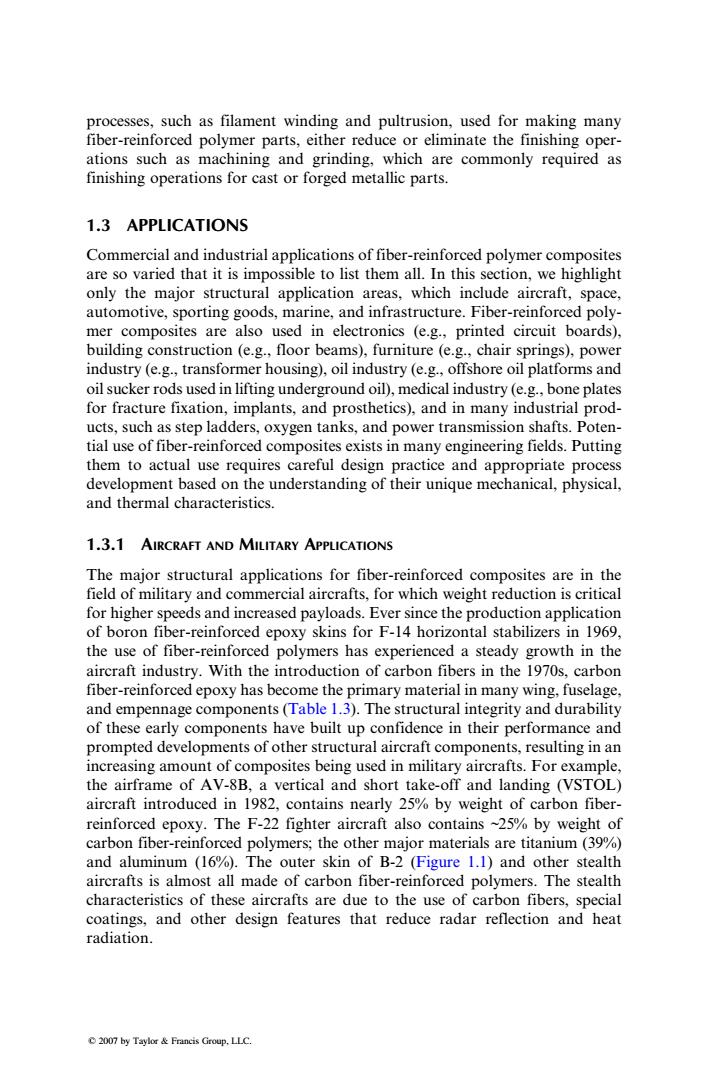正在加载图片...

processes,such as filament winding and pultrusion,used for making many fiber-reinforced polymer parts,either reduce or eliminate the finishing oper- ations such as machining and grinding,which are commonly required as finishing operations for cast or forged metallic parts. 1.3 APPLICATIONS Commercial and industrial applications of fiber-reinforced polymer composites are so varied that it is impossible to list them all.In this section,we highlight only the major structural application areas,which include aircraft,space, automotive,sporting goods,marine,and infrastructure.Fiber-reinforced poly- mer composites are also used in electronics (e.g.,printed circuit boards), building construction (e.g.,floor beams),furniture (e.g.,chair springs),power industry (e.g.,transformer housing),oil industry (e.g.,offshore oil platforms and oil sucker rods used in lifting underground oil),medical industry (e.g.,bone plates for fracture fixation,implants,and prosthetics),and in many industrial prod- ucts,such as step ladders,oxygen tanks,and power transmission shafts.Poten- tial use of fiber-reinforced composites exists in many engineering fields.Putting them to actual use requires careful design practice and appropriate process development based on the understanding of their unique mechanical,physical, and thermal characteristics. 1.3.1 AIRCRAFT AND MILITARY APPLICATIONS The major structural applications for fiber-reinforced composites are in the field of military and commercial aircrafts,for which weight reduction is critical for higher speeds and increased payloads.Ever since the production application of boron fiber-reinforced epoxy skins for F-14 horizontal stabilizers in 1969, the use of fiber-reinforced polymers has experienced a steady growth in the aircraft industry.With the introduction of carbon fibers in the 1970s,carbon fiber-reinforced epoxy has become the primary material in many wing,fuselage, and empennage components (Table 1.3).The structural integrity and durability of these early components have built up confidence in their performance and prompted developments of other structural aircraft components,resulting in an increasing amount of composites being used in military aircrafts.For example, the airframe of AV-8B,a vertical and short take-off and landing (VSTOL) aircraft introduced in 1982,contains nearly 25%by weight of carbon fiber- reinforced epoxy.The F-22 fighter aircraft also contains ~25%by weight of carbon fiber-reinforced polymers;the other major materials are titanium(39%) and aluminum (16%).The outer skin of B-2 (Figure 1.1)and other stealth aircrafts is almost all made of carbon fiber-reinforced polymers.The stealth characteristics of these aircrafts are due to the use of carbon fibers,special coatings,and other design features that reduce radar reflection and heat radiation. 2007 by Taylor Francis Group,LLC.processes, such as filament winding and pultrusion, used for making many fiber-reinforced polymer parts, either reduce or eliminate the finishing operations such as machining and grinding, which are commonly required as finishing operations for cast or forged metallic parts. 1.3 APPLICATIONS Commercial and industrial applications of fiber-reinforced polymer composites are so varied that it is impossible to list them all. In this section, we highlight only the major structural application areas, which include aircraft, space, automotive, sporting goods, marine, and infrastructure. Fiber-reinforced polymer composites are also used in electronics (e.g., printed circuit boards), building construction (e.g., floor beams), furniture (e.g., chair springs), power industry (e.g., transformer housing), oil industry (e.g., offshore oil platforms and oil suckerrods used in lifting underground oil), medical industry (e.g., bone plates for fracture fixation, implants, and prosthetics), and in many industrial products, such as step ladders, oxygen tanks, and power transmission shafts. Potential use of fiber-reinforced composites exists in many engineering fields. Putting them to actual use requires careful design practice and appropriate process development based on the understanding of their unique mechanical, physical, and thermal characteristics. 1.3.1 AIRCRAFT AND MILITARY APPLICATIONS The major structural applications for fiber-reinforced composites are in the field of military and commercial aircrafts, for which weight reduction is critical for higher speeds and increased payloads. Ever since the production application of boron fiber-reinforced epoxy skins for F-14 horizontal stabilizers in 1969, the use of fiber-reinforced polymers has experienced a steady growth in the aircraft industry. With the introduction of carbon fibers in the 1970s, carbon fiber-reinforced epoxy has become the primary material in many wing, fuselage, and empennage components (Table 1.3). The structural integrity and durability of these early components have built up confidence in their performance and prompted developments of other structural aircraft components, resulting in an increasing amount of composites being used in military aircrafts. For example, the airframe of AV-8B, a vertical and short take-off and landing (VSTOL) aircraft introduced in 1982, contains nearly 25% by weight of carbon fiberreinforced epoxy. The F-22 fighter aircraft also contains ~25% by weight of carbon fiber-reinforced polymers; the other major materials are titanium (39%) and aluminum (16%). The outer skin of B-2 (Figure 1.1) and other stealth aircrafts is almost all made of carbon fiber-reinforced polymers. The stealth characteristics of these aircrafts are due to the use of carbon fibers, special coatings, and other design features that reduce radar reflection and heat radiation. 2007 by Taylor & Francis Group, LLC